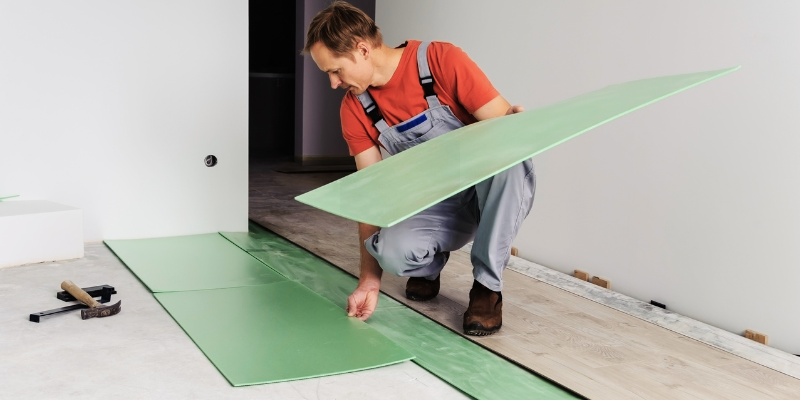When planning a new flooring project, one of the most common questions is: “Do you need underlayment?” Flooring underlayment is a thin layer of material placed between your subfloor and the finished flooring. While it’s often hidden, underlayment plays a crucial role in how your floor feels, sounds, and lasts over time.
Homeowners and contractors ask this question because the need for underlayment depends on several factors: the type of flooring you choose, the condition of your subfloor, and whether you need extra features like moisture protection, sound reduction, or added comfort.
In this complete guide, we’ll break down everything you need to know about flooring underlayment—from what it is, when it’s required, and the benefits it offers, to the different types available, costs, and installation tips—so you can decide with confidence whether your next flooring project really needs underlayment.
What Is Flooring Underlayment?
Flooring underlayment is a thin layer of material—such as foam, cork, rubber, felt, or plywood—installed between the subfloor and the finished flooring surface. Its main purpose is to provide support, reduce noise, manage moisture, and improve comfort underfoot.
Underlayment is used across many flooring types, including laminate, vinyl planks, hardwood, tile, and carpet. For example, laminate floors almost always require foam or cork underlayment, while carpet installations rely on thick padding as the underlayment layer.
It’s also important to distinguish between underlayment and subfloor. The subfloor is the structural base (usually plywood or concrete) that sits directly on the joists. The underlayment, on the other hand, is an additional layer that enhances performance and helps the top flooring last longer.
Do You Really Need Underlayment?
Whether or not you need underlayment depends on several key factors:
- Flooring type – Laminate and engineered wood often require it, while some luxury vinyl planks come with built-in underlayment.
- Subfloor condition – If your subfloor is uneven or prone to moisture, underlayment is highly recommended.
- Climate & moisture – In humid or basement environments, moisture-blocking underlayment can prevent damage.
- Noise reduction – Apartments, condos, or multi-level homes benefit from soundproofing layers.
- Comfort – Cushioned underlayment provides a softer feel underfoot.
Scenarios where underlayment is required:
- Floating floors (like laminate or click-lock vinyl).
- Installations over concrete subfloors.
- Projects where soundproofing or moisture protection is necessary.
Scenarios where you can skip it:
- Floors with attached underlayment.
- When the subfloor is perfectly smooth, dry, and compatible with the flooring type.
- Nail-down hardwood installations where extra layers could interfere with stability.
Benefits of Flooring Underlayment
Adding underlayment can make a noticeable difference in the comfort, durability, and performance of your floors. Key benefits include:
- Moisture protection – Prevents water or vapor from seeping up from the subfloor, protecting wood and laminate from warping.
- Sound absorption – Reduces footsteps, echoes, and impact noise, making it ideal for apartments or upper floors.
- Smoothing uneven surfaces – Minor imperfections in the subfloor are leveled out, resulting in a more stable installation.
- Comfort underfoot – Provides cushioning that makes hard floors feel softer and more comfortable to walk on.
- Extending floor life – Protects flooring from damage, helping it last longer and perform better over time.
Types of Flooring Underlayment
There are several types of underlayment, each with unique strengths:
- Foam underlayment – Lightweight and budget-friendly; best for laminate and some vinyl floors.
- Cork underlayment – Eco-friendly and excellent for soundproofing, but less moisture-resistant.
- Rubber underlayment – Dense and durable; perfect for gyms, basements, or high-moisture areas.
- Felt underlayment – Provides strong insulation and sound control; commonly used under luxury vinyl and hardwood.
- Plywood underlayment – Adds stability and is often used beneath tile or as a carpet backing base.
👉 Pros & cons: Foam and cork are affordable and easy to install, but less durable in wet areas. Rubber and felt offer premium performance but come at a higher cost. Plywood is reliable for structural support but requires professional installation.
Underlayment by Flooring Type
- Laminate flooring – Underlayment is almost always essential for sound reduction, moisture protection, and stability.
- Vinyl plank flooring – Many products come with built-in underlayment, but extra layers may be needed over concrete or in noisy spaces.
- Hardwood flooring – Nail-down hardwood usually doesn’t need it, but floating or engineered wood may benefit from foam or felt underlayment.
- Tile flooring – Uses cement board or plywood underlayment to provide a solid, stable base.
- Carpet flooring – Carpet padding acts as underlayment, adding comfort, insulation, and noise reduction.
How to Choose the Right Underlayment
Choosing the right underlayment depends on your space, flooring type, and lifestyle needs. Here are the main factors to consider:
- Moisture levels – For basements or concrete subfloors, pick underlayment with a built-in vapor barrier. Upstairs rooms with low moisture risk may only need foam or cork.
- Soundproofing needs – If you live in a condo, apartment, or multi-story home, opt for cork, felt, or rubber to minimize noise transfer.
- Comfort vs durability – Foam offers extra cushioning but may wear down faster in high-traffic areas. Rubber and felt are tougher but firmer underfoot.
- Budget considerations – Foam underlayment is the most affordable, while cork, rubber, and felt are premium options. Balance cost with performance needs to get the best value.
Installation Guide: Laying Underlayment
Installing underlayment is a manageable project if you follow the right steps.
Tools required: Utility knife, tape measure, straightedge, underlayment tape, and safety gear.
Step-by-step process:
- Prepare the subfloor – Clean, dry, and level it before installation.
- Roll out underlayment – Lay sheets or rolls flat, with edges butted (not overlapped).
- Trim and fit – Cut neatly around walls, vents, and obstacles.
- Tape seams – Use underlayment tape to secure joints and prevent shifting.
- Install flooring – Once underlayment is in place, proceed with your chosen flooring.
Common mistakes to avoid:
- Skipping subfloor leveling, which can cause uneven flooring.
- Overlapping seams, leading to bumps under floors.
- Using the wrong underlayment in moisture-heavy areas like basements.
Cost of Underlayment
The cost of underlayment varies by material and installation method.
- Average cost per sq. ft.:
- Foam: $0.25 – $0.50
- Cork: $0.75 – $1.50
- Rubber: $1.00 – $2.50
- Felt: $0.75 – $1.25
- Plywood: $1.50 – $3.00
- Foam: $0.25 – $0.50
- DIY vs professional installation:
- DIY saves on labor (typically $1–$2 per sq. ft.) but requires time and precision.
- Professionals ensure flawless installation, especially for plywood or rubber underlayments.
- DIY saves on labor (typically $1–$2 per sq. ft.) but requires time and precision.
- Long-term ROI: Spending a bit more upfront on the right underlayment can save you thousands by preventing moisture damage, floor squeaks, and premature replacement.
Common Underlayment Mistakes & Myths
Even experienced DIYers make errors when it comes to underlayment. Here are a few to watch out for:
- Myth: All floors need underlayment.
Not true—some vinyl planks have built-in underlayment, and certain hardwood installations don’t require it. - Mistake: Using the wrong underlayment in moisture-prone areas.
Cork and foam without moisture barriers are poor choices for basements or bathrooms. - Mistake: Not leveling the subfloor first.
Underlayment smooths minor imperfections, but it won’t fix major dips or bumps.
FAQs About Flooring Underlayment
Q1. Do vinyl planks with attached underlayment need extra?
Not usually, but an added moisture barrier may be needed if installed over concrete or in damp areas.
Q2. Can you use carpet padding as underlayment for other floors?
No—carpet padding is too soft and unstable for laminate, hardwood, or vinyl flooring.
Q3. What happens if you skip underlayment?
You may face issues like moisture damage, floor squeaks, reduced comfort, and shorter flooring lifespan.
Q4. What’s the best underlayment for basements?
Rubber or foam with a vapor barrier are ideal for moisture-heavy basement environments.
Conclusion
So, do you really need underlayment? The answer depends on your flooring type, subfloor condition, and home environment. In many cases—like laminate, engineered wood, or basements—underlayment is essential for comfort, durability, and protection. In others, such as floors with attached padding, you may be able to skip it.
While underlayment adds a small extra cost, the benefits in moisture control, soundproofing, and long-term floor performance far outweigh the expense.
👉 Before your next flooring installation, consult a flooring expert to choose the right underlayment for your space—and ensure your floors look and feel their best for years to come.

